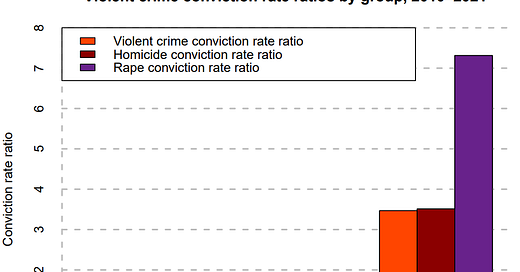
Historical Accounts of African Cannibalism
A short chronology of references to cannibalism in Africa
Introduction
When I began reading the writings of medieval Arabic scholars, I noticed something peculiar: Arabic scholars very frequently reference supposed cannibalism in black African tribes. These assertions were frequent enough that I would regularly stumble upon them, even when I wasn’t actively searching for this topic. I decided to compile these references, and here I will relay them roughly in chronological order.
Ancient accounts
Examples of writings about African cannibalism go far back. Notably, it is mentioned by the famous Greek mathematician and geographer Claudius Ptolemy (b. ~100 AD) who lived in Alexandria, a city established in present-day Egypt while under the control of the ancient Greeks. In his book Geography, an early atlas, he writes the following about the eastern coasts of Africa: “The bay from Rhapta to Cape Prason is very big and not deep, and barbarous cannibalism live about it.” And, in the chapter where he describes interior regions of “Aethiopia”, he says “Around this bay the Aethiopian Anthropophagi [cannibals] dwell.”1 The word “Aethiopia” did not refer to present-day Ethiopia, but was then a more generic term applied to Sub-Saharan Africa.
Medieval Middle Eastern accounts
Jump forward a few centuries — the Western Roman Empire has greatly declined, and Europeans no longer have much contact with Sub-Saharan Africa. Instead, peoples of North Africa and the Middle East, especially Islamic peoples, are those who maintain any contact with the peoples of Sub-Saharan Africa. They would travel south along the Nile river or sail along the east coast of Africa, encountering the native population, often for the purpose of capturing them into slavery.
An old tale goes as follows: after a great storm while sailing (probably in the Nile), the 9th century Jewish merchant and traveler Eldad ha-Dani’s boat was wrecked, and the crew encountered cannibalistic “Ethiopian” tribes on land (again, this doesn’t necessarily refer to present-day Ethiopia). He avoided getting eaten and ultimately escaped to tell the tale.
[U]ntil the sea cast us among a people called Romranos who are black Ethiopians, tall, without garment or clothing upon them, cannibals, like unto the beasts of the field … And when we came to their country they took hold of us and, seeing that my companion was fat and healthy and pleasing, slaughtered and ate him, and he cried “Alas for me that I have been brought to this people and the Ethiopians will eat my flesh”, but me they took, for I was sick on board ship, and they put me in chains until I should get fat and well, and they brought before me all kinds of good but forbidden food, but I ate nothing and I hid the food, and when they asked me if I had eaten I answered, yes I had eaten.2
At least that is how his tale goes — though many believe it to be fictional. In fact, Islamic fiction displays a prevalent perception of black cannibalism, with it being a common theme (Southgate, 1984).3 However to avoid any confusion, none of the following references will be drawn from works of fiction.
In the works of medieval Islamic scholars, you see an abundance of references to African cannibalism. Around 947 AD, geographer and historian al-Masudi writes that “Some of their tribes have sharpened their teeth and are cannibals.”4 In describing the animistic tribes of Africa, he also says “They fight amongst themselves. They eat people.”5 And around 966 AD, Arabic geographer al-Maqdisi describes the Zanj (blacks) as cannibals.6
These assertions continue for centuries. Thirteenth century Ibn Sa’id recorded the accounts of the traveler Ibn Fatima, describing the Kanem and other people surrounding Lake Chad, “It [Lake Chad] is surrounded on all sides by peoples of the Sudan [black peoples], cruel pagans who eat men.”7 Fourteenth century historian al-Umari mentions pagan populations neighboring the Mali Empire of West Africa, “among them are some who eat human flesh.”8 It is also mentioned by fourteenth century Ibn Khaldun, perhaps the most influential medieval Arabic scholar, that “They frequently eat each other.”9
Ibn Battuta’s account
Perhaps the most convincing medieval Arabic account is that of Ibn Battuta (b. 1304). Battuta is one of the world’s most famous explorers, and he traveled to West Africa himself and personally experienced and documented the local culture. Among many other places, he visited the Mali Empire (ca. 1352) and met Mansa Sulayman, whose reign of the empire began about 3 years after the death of his famous brother, Mansa Musa.
The Mali Empire was one of the largest Sub-Saharan African empires to exist; wealthy from trading gold, salt, copper and slaves. When Ibn Battuta arrived, he was offered a black slave as hospitality gift. He also encountered cannibalism. Battuta describes an anecdote of how a Sultan became angry with a qádí [Islamic Judge], and exiled him “to the country of the heathen cannibals.” Even more illustrative is Battuta’s personal encounter. He says:
A group of these Blacks who eat the sons of Adam came to the Sultan Mansa Sulaiman with their amir [leader/prince]. It is their custom to put in their ears big pendants, the opening of each pendant being half a span across. They wrap themselves in silk and in their country is a gold mine. The Sultan treated them with honour and gave them in hospitality a slave woman, whom they killed and ate. They smeared their faces and hands with her blood and came to the Sultan to thank him. I was told that this is their custom whenever they come on an embassy to him. It was reported of them that they used to say that the best parts of the flesh of human females were the palm of the hand and the breast.10
Early European accounts
From the 15th century on, European explorers would slowly develop more contact with Sub-Saharan Africans again, beginning with Portuguese explorers reaching the shores across the continent. Famously Bartolomeu Dias reached Cape of Good Hope in 1488. However, the European presence in Africa was mainly confined to coastal trading posts, and European exploration of Africa, particular its interior, remained rather limited until the 19th century.
Of interest to us is the account of Andrew Battel, an Englishman who became a captive of the Portuguese and ended in the pre-colonial African state Loango around the year 1610 (western part of present-day Congo). He eventually managed to return back to England. His experience is uniquely valuable in being the earliest Western account to directly witness and record his observations in the interior of this part of Africa. Here he experienced the Imbangala, a group of cannibalistic marauders:
The men, women and children that were brought in captive alive, and the dead corpses that were brought to be eaten, were strange to behold. For these Gagas [Imbangala] are the greatest cannibals and man-eaters that be in the world, for they feed chiefly upon man’s flesh [notwithstanding of their] having all the cattle of that country.11
In the following centuries, European observations and records of Africa would slowly accumulate. John Ogilby’s 1670 book Africa, largely based on the Dutch Olfert Dapper’s 1668 book, is a compilation of sources to make the most accurate descriptions of the continent then possible (mainly based on Dutch West India Company records). Several cannibalistic peoples are mentioned, including the “Temiam”, Kru people of Liberia, Kalabari people of Nigeria, various tribes around Congo, and it is mentioned of people near Liberia and Sierra Leone.12 Later books, such as James Bruce’s Travels to Discover the Source of the Nile, In the Years 1768–1773, reiterate claims of cannibalism.
Late-19th and early-20th century accounts
With the confirmation from more modern evidence, there can be little doubt that cannibalism was commonly practiced in certain regions of Africa. This is most clear in parts of Central and West Africa.
Of the places where cannibalism has repeatedly been documented, the first example is in the Congo Basin, where Andrew Battel also observed it in 1610. The Belgian officer Alexandre Delcommune (1855–1922) met a local chief, who (mistakenly) thought that one of Delcommune’s soldiers were from the Ubangi tribe, and said: “They [the Ubangi] are our enemies. Give him to me so that we can eat him.”13 Guy Burrows, while working for the Congo Independent State in the 1890s, also documented cannibalism. A local chief carrying a skull told Burrows that “he had many more at home”, they belonged to the tribes of the interior, and “the majority of whom he had eaten by himself and his family.” They further went into details:
I asked him how long it took him to eat a man. “That depends”, was the answer, “if he is a personal enemy or not” … If he is a personal enemy, I eat him all myself; but if he is only an ordinary capture I allow my wife and family to partake.”14
Multiple eyewitness accounts have attested to the practice of cannibalism, from the earliest periods of contact where the locals saw no reasons to hide the practice (after all, the European colonialists would eventually make it clear that they did not tolerate cannibalism). For example, Wilhelm Junker describes a group he called “A-Kahle” from Northeastern Zaire:
Once some Negro heads, already in an incipient putrid state, having been brought to me after a razzia, a number of A-Kahle, usually so indolent, at once hastened up to remove the flesh from the bones and eat it.15
The evidence describe above pertaining to cannibalism in Congo, as well as much more, is presented by Kajsa Ekholm Friedman in her book Catastrophe and Creation (1992).
Nigeria is another place where cannibalism has been clearly documented, particularly by the British anthropologist C. K. Meek (1885–1965). Among tribes he studied, headhunting and cannibalism were common practices, with all cannibalistic tribes being headhunting, but not vice versa. In total, he found 34 Nigerian tribes which were admittedly cannibal.16 And, among non-cannibal tribes, he found many traces of former cannibal customs. For example, he mentions that the folk-lore of the people contain myths which purport to describe the origin of cannibalism.
Modern cannibalism
Cannibalism in Africa is largely a thing of the past. As the Islamic presence increased, as pressure from European colonialists grew, and as the region modernized, cannibalism was largely eliminated. However, occasional instances of cannibalism have still been documented.
Cannibalism has been known to occur during many African civil wars. During the First Liberian Civil War (1986–1997), cannibal warlords, such as “General Butt Naked” (yes, really), would engage in cannibalism to strike terror into their enemies. Some have since been convicted for crimes of cannibalism. A 2009 Vice documentary explores the aftermath of the civil war, including the presence of cannibalism that continued well after. In an interview with Joshua Blahyi (formerly “Butt Naked”, who have since repented from his past actions and become a pastor), he tells that when they ate human flesh to satisfy hunger, they preferred the softer meats — echoing Ibn Battuta’s account from 1352, “they used to say that the best parts of the flesh of human females were the palm of the hand and the breast”.
Cannibalism has also been reported in the First Congo War (1996-1997):
During the present Civil War in the Democratic Republic of Congo, the United Nations is investigating numerous human right abuses against the Pygmy populations which have ranged from massacres, land evictions, rapes and even reports of cannibalism where Pygmies are hunted down as animals, killed and then eaten in the belief that their flesh has magical powers.17
The Mayi-Mayi militia groups also reportedly engaged in cannibalism in the Congo.18
Like civil wars in Liberia and the Congo, cannibalism has also been documented in the South Sudanese Civil War.
In Uganda, the former dictator Idi Amin reportedly engaged in cannibalism. And more recently, the “Lord’s Resistance Army” has been accused of routinely engaging in ritual or magical cannibalism. I recently encountered an interesting anecdote: a YouTuber “Sabbatical” documents his experiences while traveling across the world. In 2021, while visiting a remote village in Uganda, a local young Ugandan woman tells him about an incident of cannibalism and says that “People still do cannibalism in Uganda.” There is no way to verify her claim, but if true, it is possible that it is still practiced in certain remote communities.
Conclusion
Claims of African cannibalism have a long history. Starting with Ptolemy, Islamic scholars continued this tradition. Of course, not every early source is equally trustworthy. Some Islamic scholars merely repeated what others had written, and did not themselves travel below the Sahara, nor rely on reliable informants who had. Some were prone to exaggeration, and sometimes the descriptor of “cannibals” was applied to any pagan tribe which had yet to be explored and “civilized” by Islam.
Yet the claim of African cannibalism clearly had origin in some truth. We have little reason to doubt the observations of Ibn Battuta, for example. And later still, the practice of cannibalism was fully confirmed and documented in greater detail.
The descriptions can be find in Ptolemy’s Geography Book I, Chapter 17 and Book IV, Chapter 8, respectively. The translations are from J. Lennart Berggren and Alexander Jones’s Ptolemy’s Geography: An Annotated Translation of the Theoretical Chapters. The region “Aethiopia” is not equivalent to modern Ethiopia. The geography of Africa was still largely unknown so the term was never clearly defined. Initially, it primarily referred to the south of Egypt, such as modern-day Sudan (then Nubia). With the expansion of geographical knowledge, it sometimes came to be used more broadly to other areas south of the Sahara.
Translation taken from Elkan Nathan Adler’s Jewish Travellers (1930).
Black people are portrayed as cannibals in several Persian romances of Alexander the Great. These romances are centered around a historical core, but are otherwise largely fictitious tales. Examples include the 12th century Sharaf-nama (Book of Honour) by Nizami Ganjavi; the 12th century Darab-nama by Tarsusi; and the 12th-14th century anonymous Iskandar-nama. Southgate (1984) details some of these references to cannibalism.
Black cannibalism also appears in the famous Arabian Nights story of Sinbad. As Nussbaum (2007) notes: “In Sinbad's 'Fourth Voyage,' for example, cannibal blacks seize the voyagers and fatten them with herbs and rice in anticipation of their feast.”
Al-Masudi’s The Meadows of Gold. Volume 3 in the French translation by Barbier de Meynard: “Il y a parmi eux des tribus qui ont les dents très-acérées et qui sont anthropophages.” The teeth-sharpening practice was/is a real custom in certain African tribes. That certain customs are correctly described may also give some amount of credence to the other related claims.
Al-Maqdisi’s Kitāb al-bad’ wa-l-ta’rīkh (“Book of the Creation and of History”). In tome 4 of the French translation Le livre de la création et de l'histoire by Clément Huart, the “Zendjes” are described as “anthropophages.” The term “Zanj” sometimes referred to black people in general, and sometimes more specifically to the black peoples of the East African coast.
Nehemia Levtzion & Jay Spaulding, 2003. West Africa: Views from Arab Scholars and Merchants, p. 43.
Nehemia Levtzion & Jay Spaulding, 2003. West Africa: Views from Arab Scholars and Merchants, p. 54.
Ibn Khaldun’s Muqaddimah, Chapter 1, the third prefatory discussion about the temperate and the intemperate zones.
The Travels of Ibn Battuta, AD 1325–1354, Volume IV. Translated by H. A. R. Gibb.
The Strange Adventures of Andrew Battell, p. 22. The cannibalistic practices of the Imbangala are widely recognized. For example, the Encyclopedia of Africa writes: “The Imbangala also practiced ritual cannibalism, in part as a tactic to instill terror within their own group and among those they planned to fight, and in part as a sort of antireligious strategy in which they embraced practices that were considered witchcraft or evil by others.”
John Ogilby, 1670. Africa. It is mainly a translation of the 1668 book Description of Africa by the Dutch Olfert Dapper. In the section “The Kingdom or Countrey of Quoia” [Kingdom of Koya], about the Grain Coast, it is written “And in some places they must be careful of themselves; for being Cannibals, they eat whomsoever they can get into their power.” In the section THE KINGDOM OF ARDER, it is written “All the Blacks inhabiting the Easterly-shore of the greater Calabare, towards the North, are Cannibals; for they eat up whatever Enemies they kill, but their Prisoners they sell for Slaves.”
Alexandre Delcommune (1922). Vingt années de vie africaine. 1874-1893; récits de voyages d'aventures et d'exploration au Congo Belge. Volume 1, p. 286.
Guy Burrows, Edgar Canisius (1903). The Curse of Central Africa. p. 213.
C. K. Meek (1925). The Northern Tribes of Nigeria. Volume 2, p. 48-49.
ICE Case Studies Number 163, December, 2005. Pygmies in the Congo Basin and Conflict, by Raja Sheshadri.
An interesting account is documented on a travel forum. The travellers say the following: “He also told us about the Mayi-Mayi rebels that still roam the jungle. We were not prepared for the horror stories we would hear. I still have problems giving these stories a place. They are not just stories though, he gave us a 100 page document with his interviews of victims. If you thought, like us, that cannibalism was something that belonged in comic books and dusty museums about Africa. You are wrong.”
They give multiple accounts of cannibalism. One of them: “Y's brother went fishing in Missa and saw mischief like cutting of ears. They fry the ears in a pan eat them. They make the victims look at how their own ears are being fried and eaten. They are being accused of cooperation with the Congolese FAC army. The May May continue to eat humans. Y's brother managed to escape to Bukama, this is where I met him.”
Further, they mention they were there in 2008 and the latest account of cannibalism was in 2006.















African cannibalism of albinos is still widespread especially in East Africa.
London, too:
https://www.theguardian.com/uk/2002/nov/03/ukcrime.antonybarnett